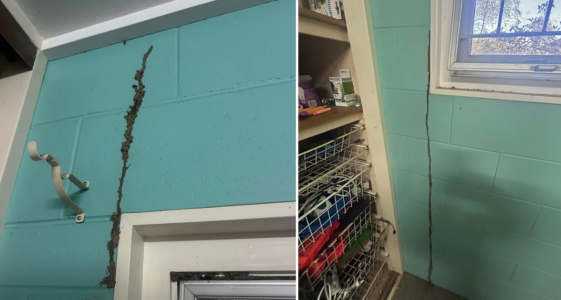Costly homeownership myth catches Aussies off guard too late
By
- Replies 6
Owning a home is seen by many as a key part of feeling settled and secure.
But behind this dream lies a hidden challenge that has surprised many, leading to unexpected financial strain.
It's an important reminder that some learn too late about the risks that can come with what seems like a safe investment.
The myth in question is that brick homes are impervious to termite damage.
This misconception has led many homeowners to overlook the need for regular termite inspections, only to discover extensive damage when it's far too late.
Termites, those insidious little critters, don't discriminate between brick and timber; they'll happily munch through any wood they can find, including the timber structure of your roof, doorways, and windowsills.
A recent reminder from a pest control company in Ipswich, Queensland, has again brought this issue to the forefront.
They shared alarming photos of termite tracks burrowing through a brick home, challenging the belief that brick walls offer complete protection.
'My house is a brick block house, it can’t get termites…' is a statement they've heard all too often, followed by the harsh reality of termite infestation.
Christopher James, a Sydney-based pest controller, talked about the pervasive threat of termites.
'Nobody’s immune to termite damage,' he said.
'When you've got a brick home, a double brick home, it doesn't really matter too much.'
'A brick home still has a timber structure roof. It'll still have doorways, windowsills, eaves that can still be eaten.'
Termites are subterranean creatures that can travel undetected over and through brick to reach their next timber target.
The damage they cause can be catastrophic, potentially' destroying a whole house' in less than a year while remaining invisible to the untrained eye.
"You don't really see the damage or know they're there until it's too late,' James added.
Australia is home to over 200 species of termites, but only a few pose a significant threat to our homes.
These colonies thrive in warm, humid weather, typically during spring and autumn.
'Termites are pretty rampant; we're doing about five or six calls out every week...we're always finding lots of termites,' James said.
Pest control professionals have taken to social media to share their disturbing finds and offer advice on what signs homeowners should look out for.
The consensus among experts is clear: Homeowners should schedule termite inspections every one to two years.
While the cost of an inspection is a few hundred dollars, it pales compared to the potential treatment costs, ranging from $2,000 to $8,000.
Prevention is key when it comes to termites. Jhy Carroll from EBS Queensland outlines two main preventative measures: chemical barrier treatments and in-ground baiting systems.
Chemical barriers involve treating the soil around the home's perimeter, while baiting systems use bait to eliminate termite colonies.
As seniors, staying vigilant about home maintenance is crucial, and termite protection should be high on the list.
Regular inspections and preventative measures can save you from the heartache and financial strain of extensive termite damage.
We urge our members to consider the risks and proactively safeguard their homes.
Remember, when it comes to termites, it's better to be safe than sorry. Don't let this costly myth eat away at your dream of homeownership.
Credit: TikTok
 Have you had a termite inspection recently, or perhaps experienced the misfortune of termite damage? Share your stories with us in the comments below. Your experience could be a valuable warning to others in our community.
Have you had a termite inspection recently, or perhaps experienced the misfortune of termite damage? Share your stories with us in the comments below. Your experience could be a valuable warning to others in our community.
But behind this dream lies a hidden challenge that has surprised many, leading to unexpected financial strain.
It's an important reminder that some learn too late about the risks that can come with what seems like a safe investment.
The myth in question is that brick homes are impervious to termite damage.
This misconception has led many homeowners to overlook the need for regular termite inspections, only to discover extensive damage when it's far too late.
Termites, those insidious little critters, don't discriminate between brick and timber; they'll happily munch through any wood they can find, including the timber structure of your roof, doorways, and windowsills.
A recent reminder from a pest control company in Ipswich, Queensland, has again brought this issue to the forefront.
They shared alarming photos of termite tracks burrowing through a brick home, challenging the belief that brick walls offer complete protection.
'My house is a brick block house, it can’t get termites…' is a statement they've heard all too often, followed by the harsh reality of termite infestation.
Christopher James, a Sydney-based pest controller, talked about the pervasive threat of termites.
'Nobody’s immune to termite damage,' he said.
'When you've got a brick home, a double brick home, it doesn't really matter too much.'
'A brick home still has a timber structure roof. It'll still have doorways, windowsills, eaves that can still be eaten.'
Termites are subterranean creatures that can travel undetected over and through brick to reach their next timber target.
The damage they cause can be catastrophic, potentially' destroying a whole house' in less than a year while remaining invisible to the untrained eye.
"You don't really see the damage or know they're there until it's too late,' James added.
These colonies thrive in warm, humid weather, typically during spring and autumn.
Recent wet weather patterns have only exacerbated the problem, with some regions experiencing heightened termite activity.'Termites are pretty rampant; we're doing about five or six calls out every week...we're always finding lots of termites,' James said.
Pest control professionals have taken to social media to share their disturbing finds and offer advice on what signs homeowners should look out for.
The consensus among experts is clear: Homeowners should schedule termite inspections every one to two years.
While the cost of an inspection is a few hundred dollars, it pales compared to the potential treatment costs, ranging from $2,000 to $8,000.
Prevention is key when it comes to termites. Jhy Carroll from EBS Queensland outlines two main preventative measures: chemical barrier treatments and in-ground baiting systems.
Chemical barriers involve treating the soil around the home's perimeter, while baiting systems use bait to eliminate termite colonies.
As seniors, staying vigilant about home maintenance is crucial, and termite protection should be high on the list.
Regular inspections and preventative measures can save you from the heartache and financial strain of extensive termite damage.
We urge our members to consider the risks and proactively safeguard their homes.
Remember, when it comes to termites, it's better to be safe than sorry. Don't let this costly myth eat away at your dream of homeownership.
Credit: TikTok
Key Takeaways
- Australian homeowners are often unaware that standard home insurance does not cover termite damage, which can be very costly.
- Brick homes are not immune to termite infestations as termites can burrow through or around brick to reach timber structures within.
- Homeowners are advised to have regular termite inspections to catch infestations early, typically every one to two years, with treatment costs varying.
- Pest control methods against termites include chemical barrier treatments and in-ground baiting systems, both aimed at protecting homes by repelling or eliminating termites.








